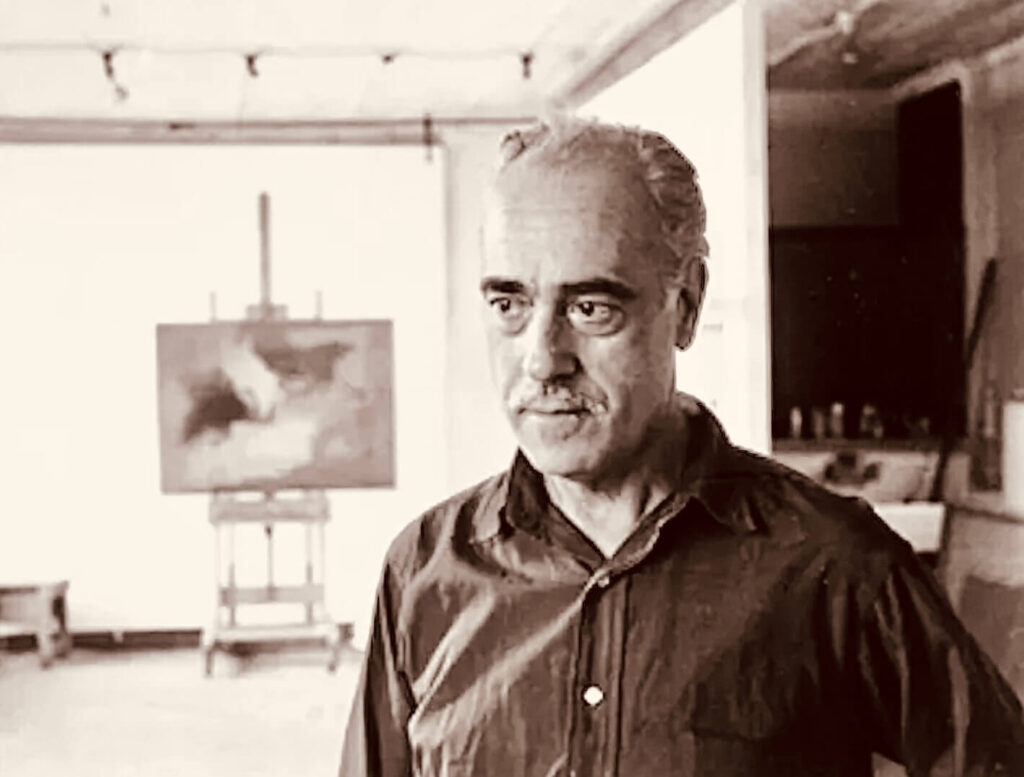Esteban Vicente
Esteban Vicente (1903-2001) was a Spanish-American painter and sculptor who became a significant figure in the Abstract Expressionist movement in the United States. His work, characterized by vibrant colors, dynamic compositions, and an intuitive approach to form, earned him a respected place among his contemporaries. Vicente’s contributions to art extend beyond his own creations; he was also a dedicated educator, influencing generations of artists through his teaching.

Early Life and Education
Esteban Vicente Pérez was born on January 20, 1903, in Turégano, a small town in Spain. His father was an army officer, and his mother was an amateur artist, which likely influenced Vicente’s early interest in art. In 1921, Vicente moved to Madrid to attend the Real Academia de Bellas Artes de San Fernando, where he studied under Daniel Vázquez Díaz. This period marked his formal introduction to art, although he was already influenced by the burgeoning modernist movements in Europe.
Vicente’s early works were rooted in traditional Spanish painting, but he quickly embraced modernism, drawn to the works of Picasso, Braque, and Gris. The political climate in Spain during the late 1920s and early 1930s, culminating in the Spanish Civil War, profoundly affected Vicente. Seeking stability and creative freedom, he moved to Paris and later to New York in 1936.
Transition to Abstract Expressionism
Vicente’s arrival in New York coincided with a critical period in American art. The city was becoming a hub for artists fleeing the turmoil in Europe, and Abstract Expressionism was beginning to take shape. Vicente quickly integrated into the New York art scene, meeting key figures like Willem de Kooning, Jackson Pollock, and Mark Rothko. These interactions significantly influenced his work.
Initially, Vicente’s style retained elements of European modernism, but he gradually moved towards abstraction. By the late 1940s, his work had evolved into pure abstraction, characterized by bold color fields and dynamic compositions. Vicente’s paintings from this period reflect his interest in the physical properties of paint and the act of painting itself.
Artistic Philosophy and Style
Esteban Vicente’s approach to art was deeply intuitive. He believed in the importance of spontaneity and the direct expression of emotion through color and form. His work often began with a simple gesture or mark, which he would then develop into complex compositions. Vicente’s use of color was particularly notable; he had an extraordinary ability to create harmony and tension through his choice and application of colors.
Vicente’s work is often described as lyrical abstraction. Unlike some of his contemporaries who favored more aggressive or dramatic approaches, Vicente’s paintings are characterized by a sense of balance and tranquility. His compositions, while dynamic, often evoke a sense of calm and introspection.
Important Artwork: “Landscape with Yellow” (1960)
One of Esteban Vicente’s most significant works is “Landscape with Yellow” (1960). This painting exemplifies his mature style and his mastery of color and form.
“Landscape with Yellow” (1960)
“Landscape with Yellow” is an oil on canvas that measures approximately 54 inches by 60 inches. The painting is a vibrant exploration of color and space, with bold swathes of yellow, green, and blue creating a dynamic yet harmonious composition. Vicente’s use of yellow as the dominant color gives the painting a sense of warmth and luminosity, while the contrasting greens and blues add depth and complexity.
The title “Landscape with Yellow” suggests a connection to nature, although the work itself is entirely abstract. Vicente often drew inspiration from the natural world, translating his observations into pure forms and colors. In this painting, the interplay of colors and the rhythmic arrangement of shapes evoke the essence of a landscape without depicting any specific scene.
Vicente’s technique in “Landscape with Yellow” is notable for its fluidity and spontaneity. He applied the paint in broad, sweeping strokes, creating a sense of movement and energy. The surface of the painting is rich with texture, as Vicente layered and blended the colors to achieve a luminous effect.
“Landscape with Yellow” is a testament to Vicente’s ability to convey emotion and atmosphere through abstraction. The painting’s vibrant colors and dynamic composition invite viewers to engage with it on a visceral level, experiencing the work as a celebration of color and form.
Teaching and Influence
In addition to his achievements as an artist, Esteban Vicente was a dedicated and influential teacher. He began teaching at Black Mountain College in North Carolina in the 1950s, a period when the school was a hotbed of artistic experimentation. Vicente’s approach to teaching emphasized the importance of personal expression and the exploration of materials and techniques.
Vicente later taught at various institutions, including the University of California, Berkeley, Yale University, and the New York Studio School. His impact on his students was profound; many of them went on to become significant artists in their own right. Vicente’s emphasis on intuition and spontaneity, combined with his deep understanding of color and composition, helped shape the artistic practices of a new generation.
Later Career and Legacy
Esteban Vicente continued to create and exhibit his work well into his later years. His paintings and collages evolved over time, but they consistently reflected his commitment to abstraction and his mastery of color. Vicente’s later works often featured more muted palettes and a greater emphasis on subtle tonal variations, demonstrating his continued exploration of the possibilities of paint.
Vicente received numerous accolades throughout his career, including a Guggenheim Fellowship and a National Endowment for the Arts grant. His work has been exhibited in major museums and galleries worldwide, including the Museum of Modern Art in New York, the Art Institute of Chicago, and the Reina Sofia Museum in Madrid.
Vicente’s contributions to art were not limited to his own creations; he also played a significant role in the broader art community. He was a founding member of the New York Studio School, an institution dedicated to providing intensive training for artists. Vicente’s commitment to fostering artistic growth and his influence as a teacher and mentor are an integral part of his legacy.
Personal Life and Philosophy
Esteban Vicente’s personal life was characterized by a deep commitment to his art and his family. He married Harriet Peters, an American sculptor, in 1941, and they had one daughter, Mercedes. Vicente’s home and studio in Bridgehampton, Long Island, became a place of refuge and creativity, where he continued to work and explore new ideas.
Vicente’s philosophy of art was rooted in the belief that painting was an act of discovery. He viewed his work as a dialogue between the artist and the materials, a process of uncovering hidden possibilities and expressing the inexpressible. This approach is evident in the spontaneity and vitality of his paintings, which continue to resonate with viewers today.
Conclusion
Esteban Vicente’s artistic journey is a testament to his dedication, creativity, and profound understanding of color and form. Through his innovative approach to abstraction, he created a body of work that continues to inspire and captivate. “Landscape with Yellow,” one of his most important works, exemplifies his mastery of color and his ability to evoke emotion and atmosphere through abstraction.
In celebrating Esteban Vicente’s life and work, we recognize his significant contributions to the development of Abstract Expressionism and his enduring legacy as both an artist and educator. His paintings remain powerful and evocative, reminding us of the potential of art to transform our perceptions and engage with the world in new and meaningful ways.



